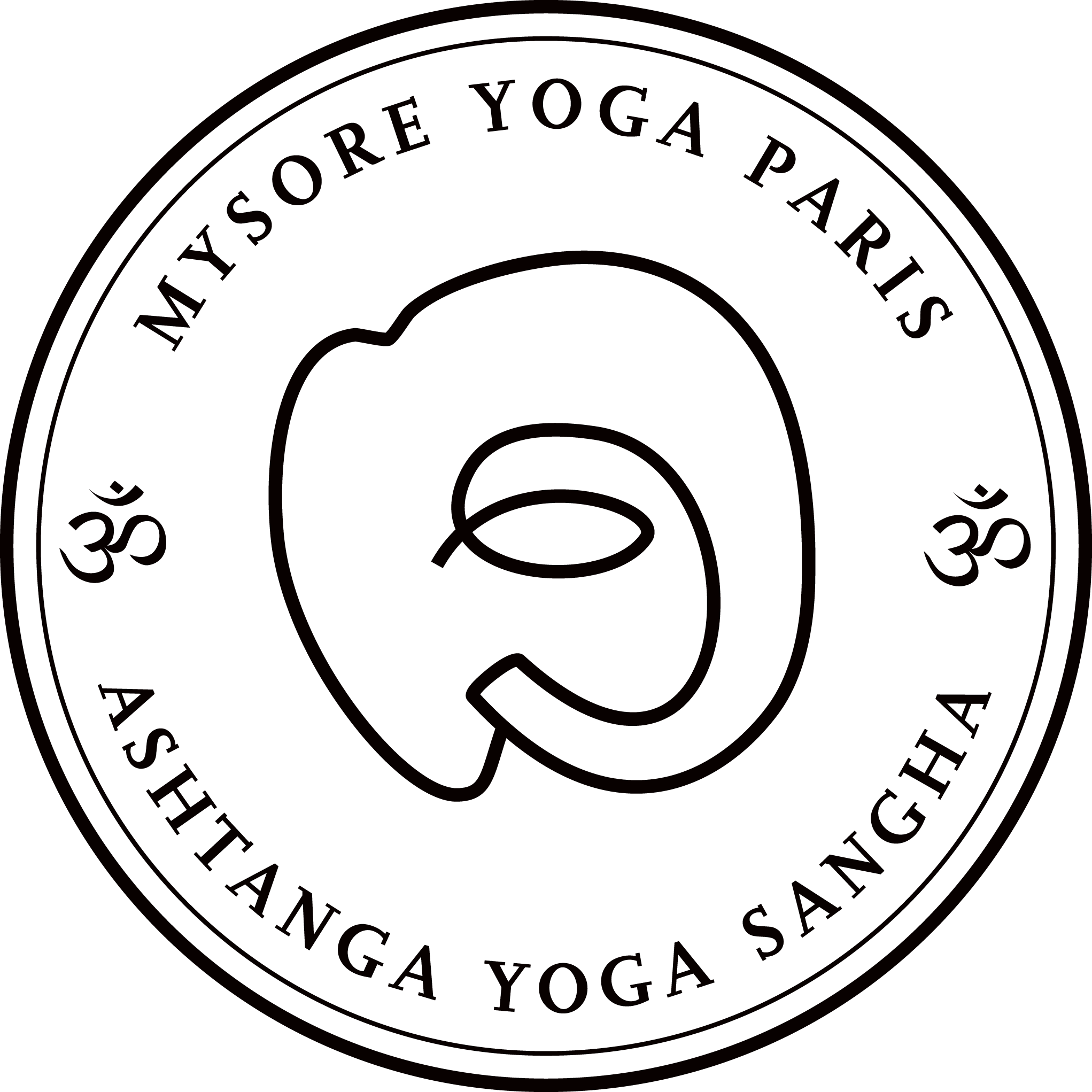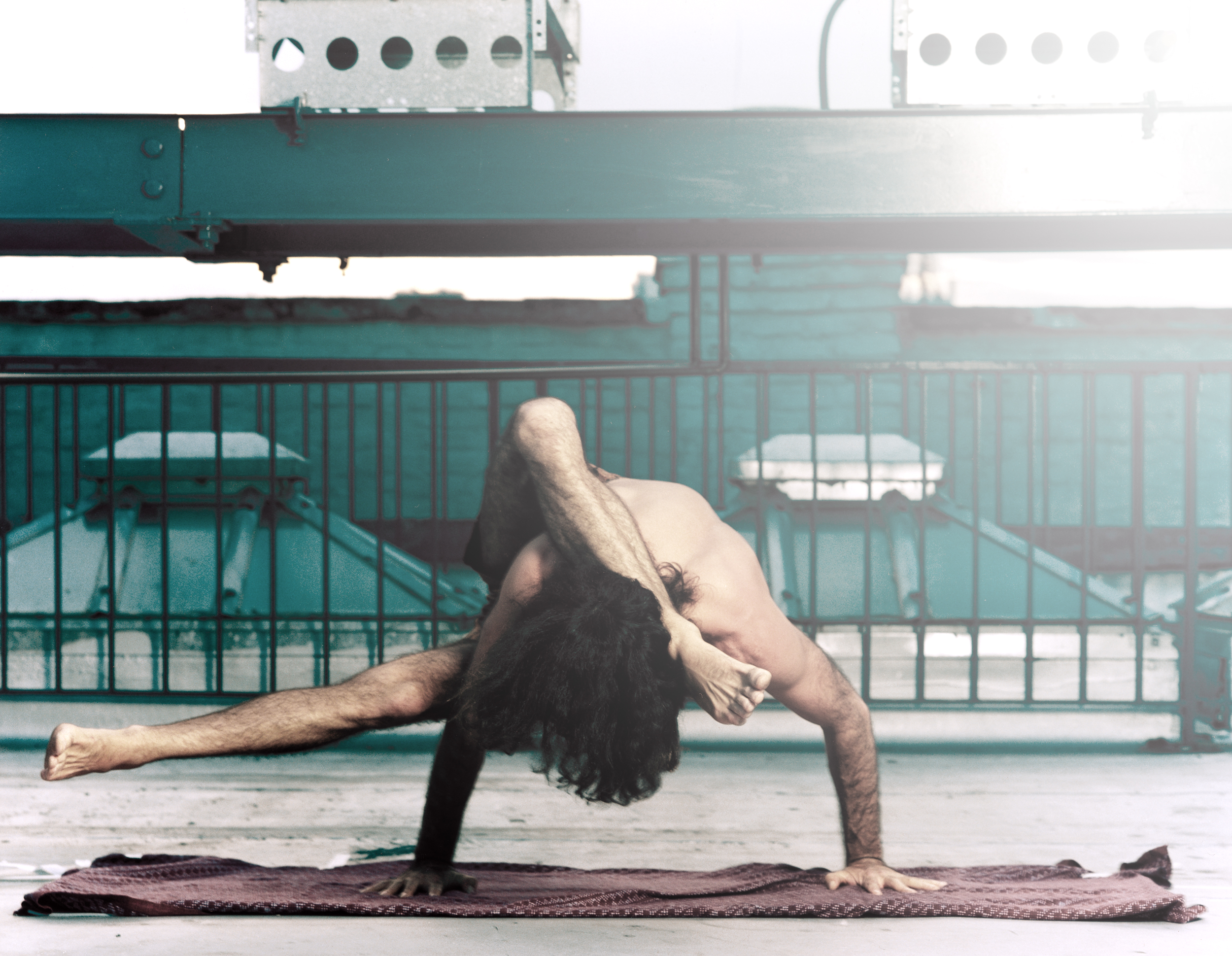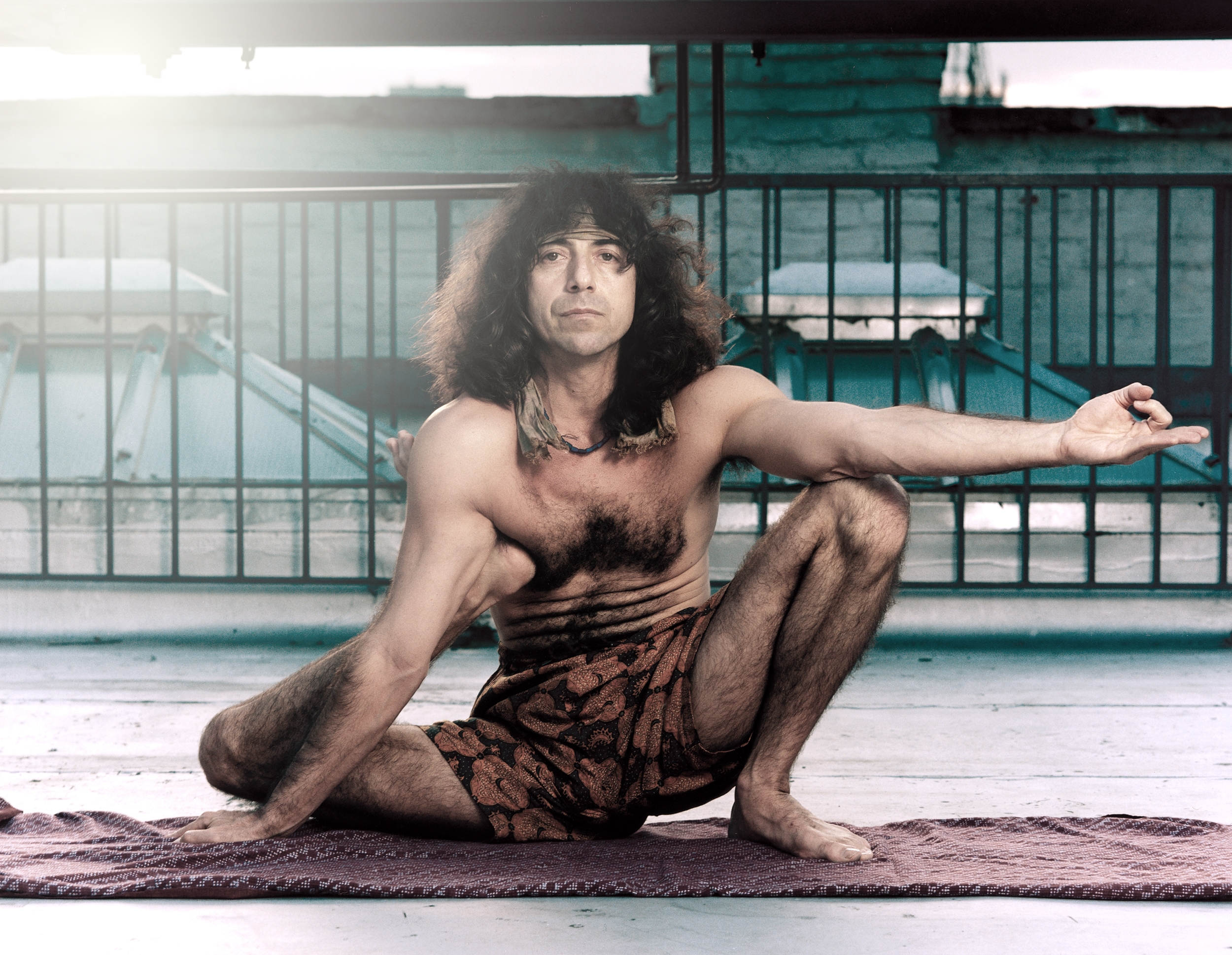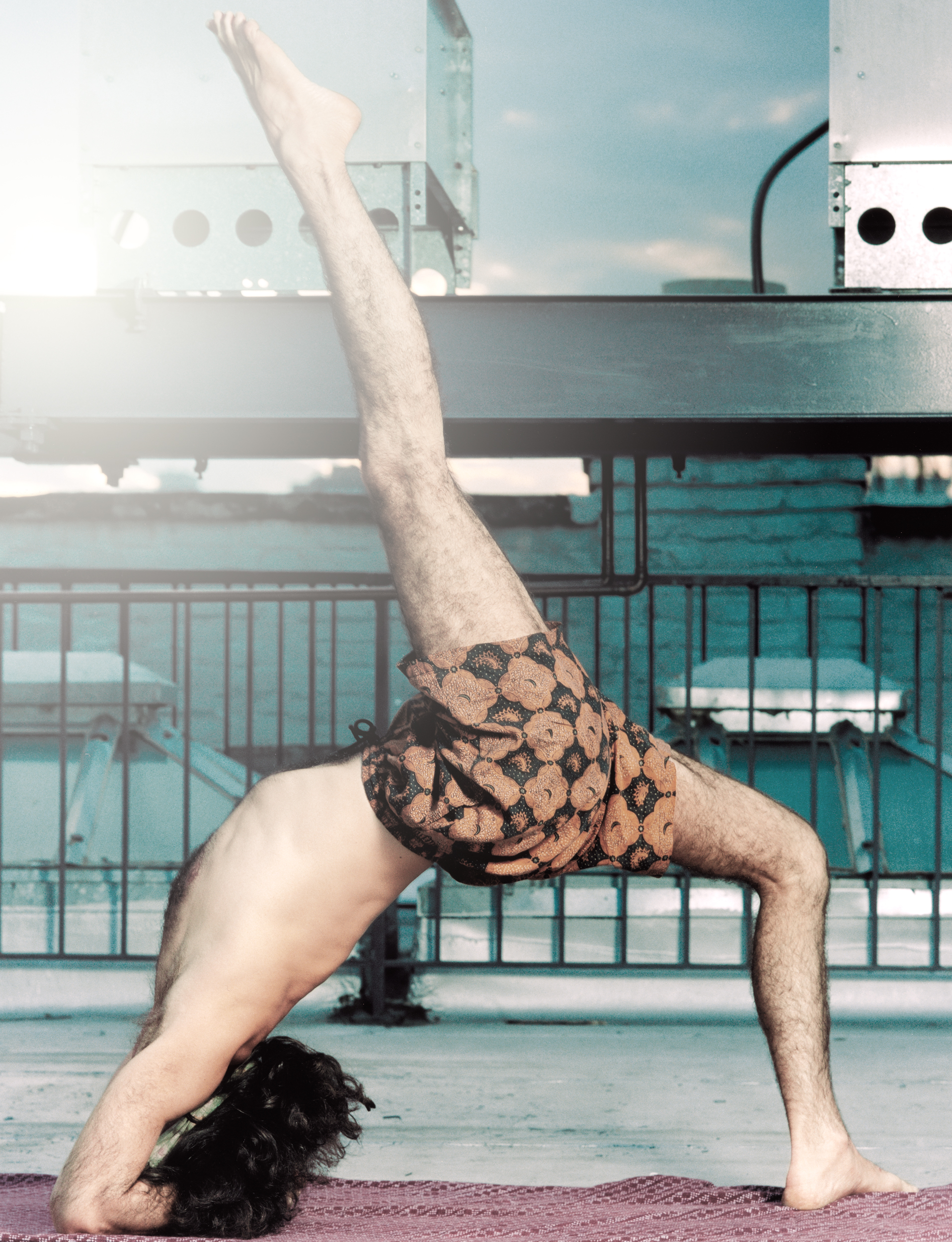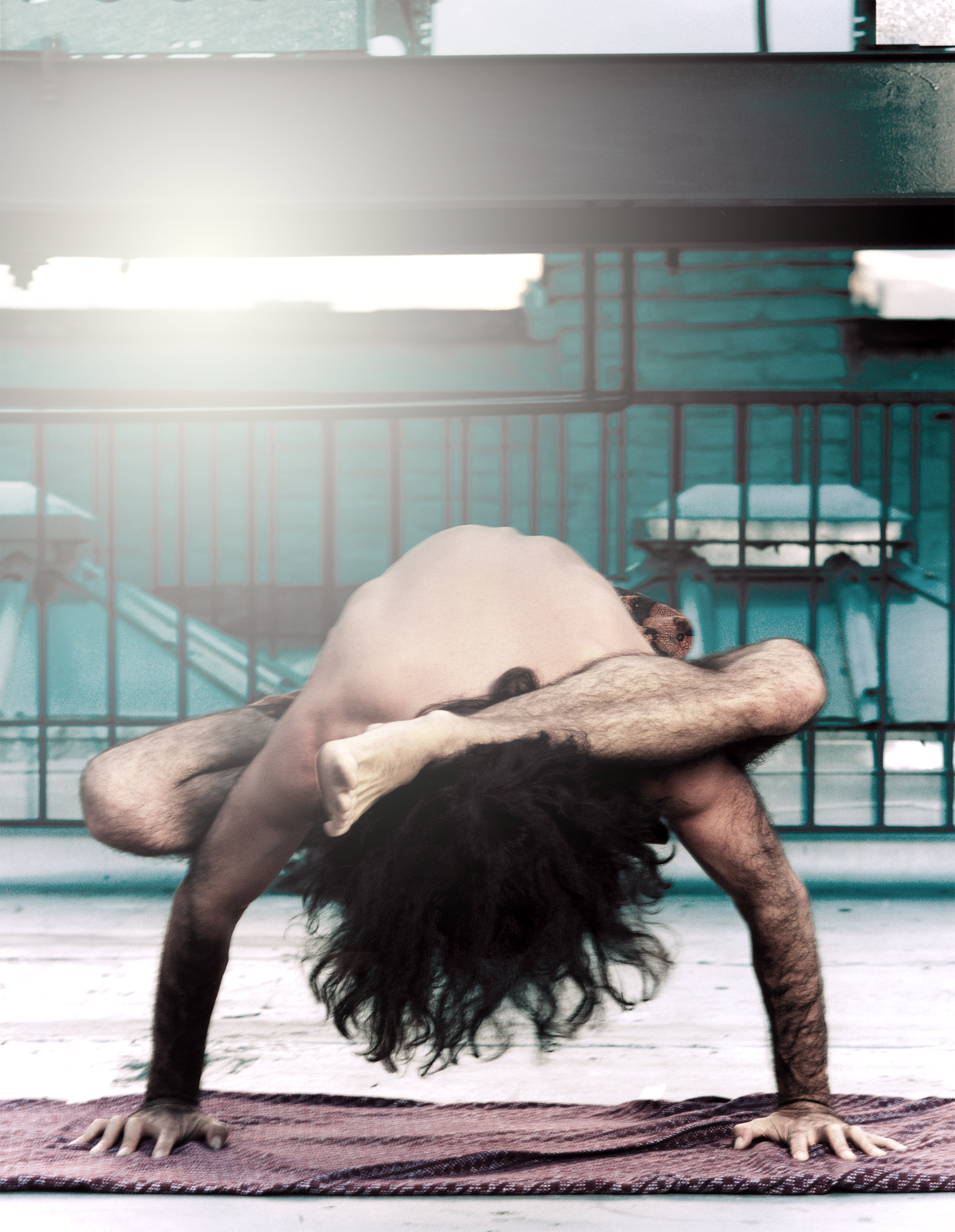Danny Paradise – Back to Nature
”Yoga comes from nature. Nature is recognized as the Teacher and Guide in all Shamanic practices. So returning to Nature to do the practices enables you to come deeper in contact with this original force.” A conversation with Danny Paradise about purity, independence and personal responsibility.
Danny Paradise in East Village, New York 1999. Photo Kia Naddermier
I first met Danny Paradise in East Village, New York in 1999 while making a book about yoga (Om Yoga, Bokförlaget DN, 2000). The book was very much a personal research project, which led to many fascinating encounters and conversations with some of the most senior yoga teachers around. The conversation Danny and I began in New York has never really ended. Most summers we are able to spend some time together in a spectacular, pristine, remote river valley in Greece, where one of Danny’s oldest friends Cliff Barber lives as a renunciate on a simple mat, by the river. (We’ll come back to Cliff later). With Danny time and place or space are never an issue. We always pick up right where we left off, whether by e-mail or chatting by the river while he teaches my older daughter Uma some new chords on the guitar… Danny is as comfortable and easy-going with Magnus and me as he is with his 80-year old friend Cliff, my little girls or even the cats that hang around the river… His strong independence and fearlessness in expressing his beliefs and mission, whilst remaining openminded and humble, continue to inspire me in my own yoga path but perhaps even more as a human being. I’d like to share some of our conversations here in the Journal.
Take me back to the start – when and how did you first encounter Ashtanga Yoga?
– This form of Yoga chose me! David Williams and Nancy Gilgoff were pioneers in bringing Ashtanga Yoga to the West – in Encinitas, California, where they had a group of around 60 students – hippies, University students, kids… mostly young surfers. They were the first to bring Sri K P Jois and his son Manju over from India. Manju wished to stay in America when his father returned to India, and David and Nancy gave Manju their classes. So, in May 1976 they were free to come to the Hawaiian island of Maui – where I was already living – and begin teaching.
– When David and Nancy arrived on Maui, they heard there was an old Yogi there (Cliff Barber was around 45 at the time and we were in our 20’s so anyone over 35 seemed very old!) He was practicing the Asanas from Integral Hatha Yoga by Swami Satchidananda. Cliff was very studied in the scriptures of Yoga, Buddhism, Christianity and the Kabbalah and was very powerfully and clearly walking the Renunciate Path. They found him and showed him what they had been learning from Sri K. P. Jois in Mysore. Cliff spread the word to his students and friends, including myself, that David and Nancy would be giving a demonstration of all the sequences of Ashtanga Yoga, being the first Western teachers who knew and practiced them.
– It was amazing! They showed the beginning, intermediate and advanced levels of the practices, and I, along with everyone else who had watched them, showed up the next day in the historic Seaman’s Prison ground in Lahaina to try the class they were offering. This was where Cliff did his daily meditation, pranayama and Yoga practice and also where David and Nancy had met him.
– So there we were those first days in Maui – a group of 35 people practicing Yoga in the mornings in the serene historic park and a month later in a beautiful park by the ocean. Doing Yoga in amazing pristine environments quickly imprinted the practices in everyone. David and Nancy were very gentle, bright, humorous and compassionate. They taught everyone very slowly and carefully with no aggression. The first day we all did about 15 minutes and then each day if we had the strength and inclination they would add on a few minutes to the practice. Because of their careful teaching it was easy to memorize the routine gradually.
– After about a month of doing classes 6 days a week everyone had gone through the primary series. After 3 months it was totally imprinted and we were hooked. They left a few months later to visit and study in India and we all continued the practice. When they returned 6 months later most people were ready to learn the 2nd series. This pattern – of studying for 5 or 6 months and continuing on our own when they left really instilled the independence and personal responsibility of the practices… we became really self-disciplined. In the 3rd year when David and Nancy returned again to Hawaii from India many people, including myself, began to learn the 3rd or Advanced A Series. A short while I shared a house with them and began learning Advanced B or the 4th Series. These two Advanced sequences were later shortened and subdivided into Series 3, 4, 5 and 6.
Astavakrasana. Danny Paradise, East Village, New York 1999. Photo Kia Naddermier
– The Advanced positions are quite difficult but the order is a science that unlocks, heals and strengthens the body, mind and spirit. The results are so profound that it becomes clear that by doing the practices regularly, things which at first seem impossible become accessible. Ashtanga Yoga is really just Hatha Yoga in a concentrated form. It brings about profound healing and the key is to do the practice according to what is appropriate for the day. This means that some days I only feel like doing a short practice because of healing processes, energetic levels, structural changes or concentration.
– So anyone from any age group can learn these practices if they are taught slowly and carefully according to a person’s own ability. They can be modified to fit any individual’s situation.
How did the teaching begin?
– I never really intended to teach, but in 1979 David Williams asked me to assist him in a new class he was starting. In that same year, Ganga White invited me to introduce Ashtanga Yoga at his Center for Yoga in Los Angeles. Then a friend who had studied in the original classes in Hawaii invited me to Goa, India and in February 1983 I went to help him teach a group of young people from all over the world. That friend, by the way, was my old friend and teacher from Maui, Cliff Barber. That is how I began my Yoga-teaching journey…
– As the first Western traveling teacher who knew all the classical sequences of Ashtanga Yoga, I started receiving invitations from all over the world. And I continue following those invitations even now.
You have been practicing Ashtanga Yoga and the asana practices associated with Ashtanga Yoga through many stages of your life. Has your practice changed much over the years?
– Over the years I’ve practiced Yoga with many friends who have introduced me to asanas that aren’t specifically in the Ashtanga Yoga routines but are derivatives of asanas or extensions of various positions from sequences in Ashtanga. Each position has endless variations or derivative positions, and as I learned these variations I began incorporating them in my practice and teaching them. This for me keeps the integrity of the practice and also makes it continuously challenging and constantly expanding.
– I also practice and teach positions from Kung Fu that I learned from a Master in Taipei, Taiwan. I feel they are derivative ideas and extensions of various yoga asanas. Since visiting Egypt in 1987 and seeing the ancient Temples of Karnak and Luxor, I wonder whether Indian classical Yoga may have originated there. Many asanas are represented in the Hieroglyphs carved into the temple walls. Spinal twists, downward dog, shoulder stand, wheel and many other positions are clearly depicted. The precise ages of the Temples are unknown but they are probably much older than any one realizes and certainly older than the culture of India. India was where yoga was refined but Egypt may have been the source.
– I use to practice the advanced sequences of Ashtanga regularly, but now I pick and choose aspects of the advanced series when I wish to work on them. Some of the more extreme positions I leave out or modify now that I’m older. Fortunately I’m still able to do a lot of the practices as well as teach them.
– I continue to do the Pranayama practices of Ashtanga Yoga and a regular daily asana practice always looking for what is appropriate for that day.
What are your thoughts around purity in terms of how we practice and live our lives?
– Yoga and Shamanism are explorations of purity and purification. As the Buddha said ”You are responsible for your own purity and your own purification. Who else? No one purifies another…”
– Of course it is a rare individual that can be perfectly pure but at least the practices of Yoga continuously help us to purify our minds and bodies and help us recognize that we are responsible for our own health, healing and well-being. Personal responsibility and personal authority are clear teachings in all Shamanism and in the Shamanic practices and teachings of Yoga. One of the beautiful teachings of all Shamanic practices is: ”If you have a disciplined life… If what you eat and think are pure… watching what you eat, what you drink, what you say… how you think… If you manage to become disciplined, you can receive visions, knowledge, enter into contact with Spirits and go to an endless depth on your Spiritual path…” (Pablo Amaringo, Peruvian Shaman).
– In other words as we purify and become more responsible – we receive more responsibility. Another way to express this: The more disciplined we are, the purer we eat, the simpler we live, think and act – all contribute towards clarity and our ability to communicate with our own soul… We are nature and we all have a Nature Soul. Yoga is a journey back to nature. Our Nature Soul is in conflict with our rational mind, with the Modern world, all the noise and distractions of the cities, negative news, overloaded media and the chemical poisons… This conflict is the source of much disease and imbalance in our world today. The practices of Shamanism and Yoga help develop our nutrition, perception, insight and ways of seeing. They are practices which heal, help us learn to have regular communication with the Great Spirit, put us back in communication with our soul and carry us on a path of evolutionary consciousness. They create personal authority and personal responsibility leading us to Universal Responsibility.
– By the way The Sramanas were the original Shaman Yogis of Asia thousands of years ago and they carried the ascetic heat building practices, disciplines and meditations of Yoga as well as the knowledge of the Medicine plants. I wrote this for the book Sacred Sanskrit Words by Reema Datta and Leeza Lowitz ”The shaman can be defined as one who lives within nature and perceives nature as the spiritual teacher/healer. The ŗişis who ’saw’ the practice of yoga under deep meditation were a type of shaman, since they resided in nature, receiving all nutrition and protection directly from natural sources. To this day, shamans in South America, Africa, Asia, and other parts of the world continue to receive great spiritual insight from the way their lives are immersed in nature.”
Your retreats and workshops are often held in very ”pure” places in, or close to nature, how does this effect us and our practice?
– Yoga comes from Nature. Nature is recognized as Teacher and Guide in all Shamanic practices. So returning to Nature to do the practices enables you to come deeper into contact with this original force. Something profound happens when you practice by a river, in the forest, by the ocean… in the wind. These days I hear that there is some kind of ridiculous rule that Ashtanga Yoga must be practiced in a small room with the windows closed… Krishnamacharya studied for seven years with his teacher in a cave in Tibet. The practices were created through meditative communication with nature.
– If you live in a city then it may be necessary to learn yoga in a studio downtown, but whenever possible do the practices in a garden, forest or park and find out what happens… You absorb different information if you practice in a pristine environment or even just your backyard garden. The problem these days is that we are disconnected from our Nature Soul. The Rational mind dominates and this is the source of many diseases, depression and conflict in our lives. The Native Americans say if you need energy, go outside and take a deep breath. This is where energy comes from. The original Yogis recognized that Prana came from the air and explored that to its deepest levels.
– My retreats are always in the most beautiful, powerful natural environments that I’ve found: Thailand, Brazil, Crete, Tanzania, The Yukon Territories in Canada, Turkey, India… The locations themselves are Tirthas – crossing-over places – where the ordinary world meets the extraordinary. Some of my retreats are in National Wildlife Sanctuaries where, when you practice Yoga, the animals come closer because they recognize you are entering their wavelength. It takes this shift in perception, the slowing down of the brain wave pulse… this happens through deep breath and in the presence of nature. It moves perception from Beta to Alpha and Theta states. Then we see further and deeper and also enter into the deep healing fields. Somehow the animals and birds recognize this shift in humans and come closer to see what is happening. You can even see this at home when you practice. A cat will come closer as they recognize you’ve entered into their field of perception. It’s a beautiful, magical result.
You are a big traveler, do you have ideas for how to make traveling less exhausting for our planet?
– Treat travel as a privilege, a sacred gift and responsibility. If all travel is pilgrimage then something different happens in the mind and spirit. The soul is affected and engaged.
– I travel for work and for exploration of cultures worldwide. It is a sacred privilege for me to come to cultures around the world and exchange ideas with friends who are interested in the healing practices, in Shamanism, in Evolutionary Consciousness, in music. I am encouraging people to be independent, to be their own Master… to not follow so called ‘external masters’ but to recognize that these ancient evolutionary teachings lead the practitioner to Mastery in their own life. Mastery of their dream, Mastery of aging and hopefully Mastery in the great journey of Transition.
– I also encourage people to support organic agriculture and sustainable energy systems in their local communities, to use their voice to create positive change, to fight against the lack of regulation of the chemical corporations, the nuclear and GMO industry whose only motivation is profit without a care for the future and the coming generations. Yoga centers are becoming centers of activism. The influence of individuals who are awake and conscious cannot be underestimated. There is a war going on between those who are destroying nature and those who wish to preserve, protect and restore the environment.
– Hopefully the work I’m doing somehow balances out the negative impact of traveling. I hope that technology shifts in the near future so that there is somehow less pollution, less degradation of the environment. The science is already there, now commercial enterprises have to implement the technology.
How do you balance your practice to sustain your intense traveling and teaching schedule?
– I always give myself time to recover from long trips before I teach. I need to be in the time zone for a while before I feel balanced and ready. I also do not teach all the time. I take long breaks in pristine environments to catch up with myself, to continue to learn and explore new ideas and of course I maintain a regular Yoga practice. I also play music, write songs, record and perform. This is a deep meditative practice for me that helps to create balance in my life.
Extract from one of Kia’s & Danny’s many conversations, September 2014.
Images by Kia Naddermier from the book Om Yoga.
For Danny Paradise workshops & retreats please visit: www.dannyparadise.com
